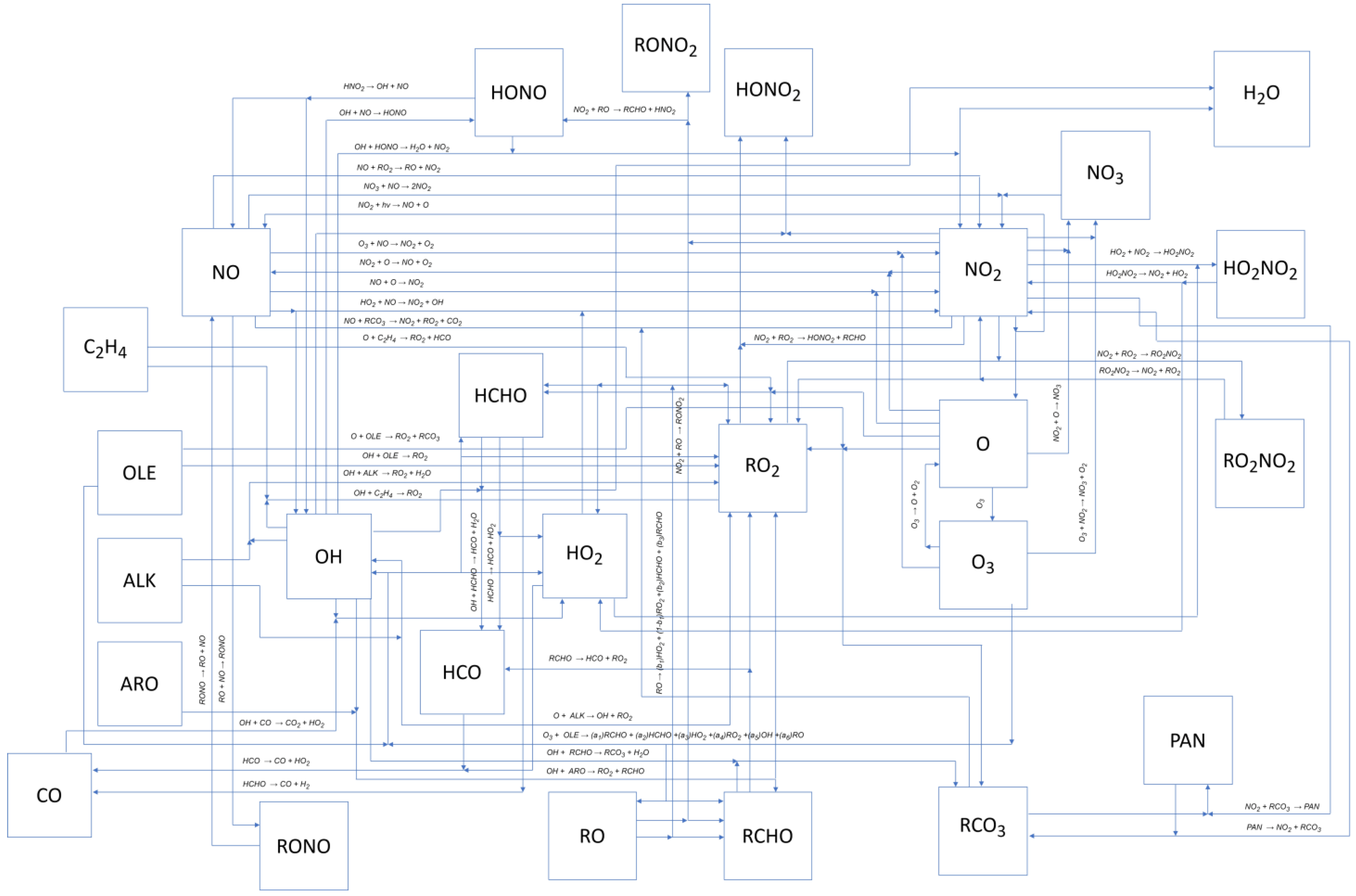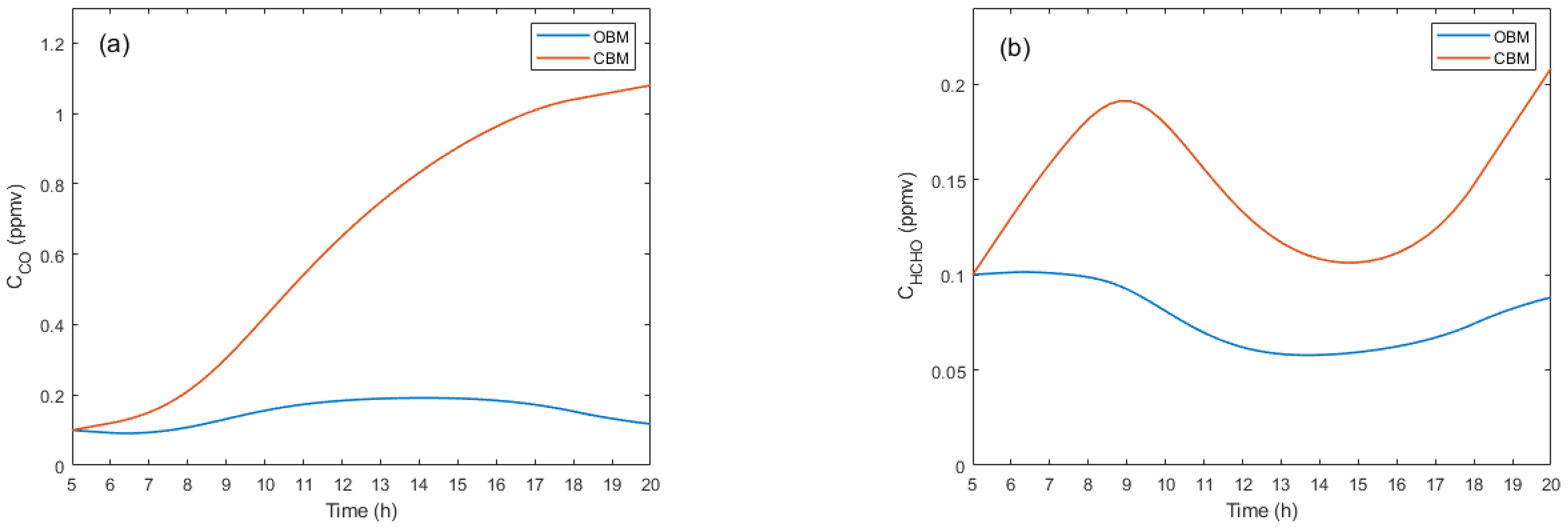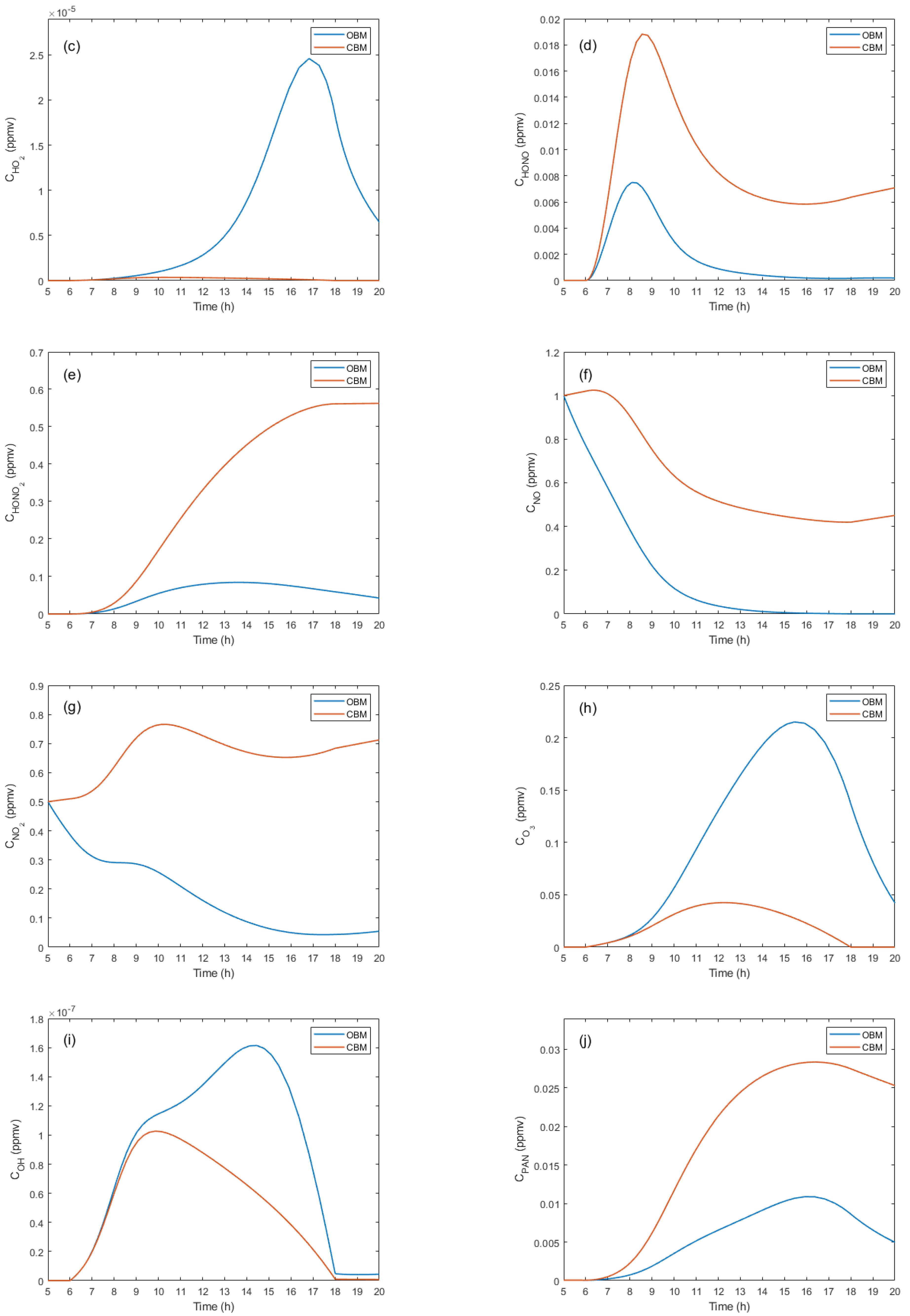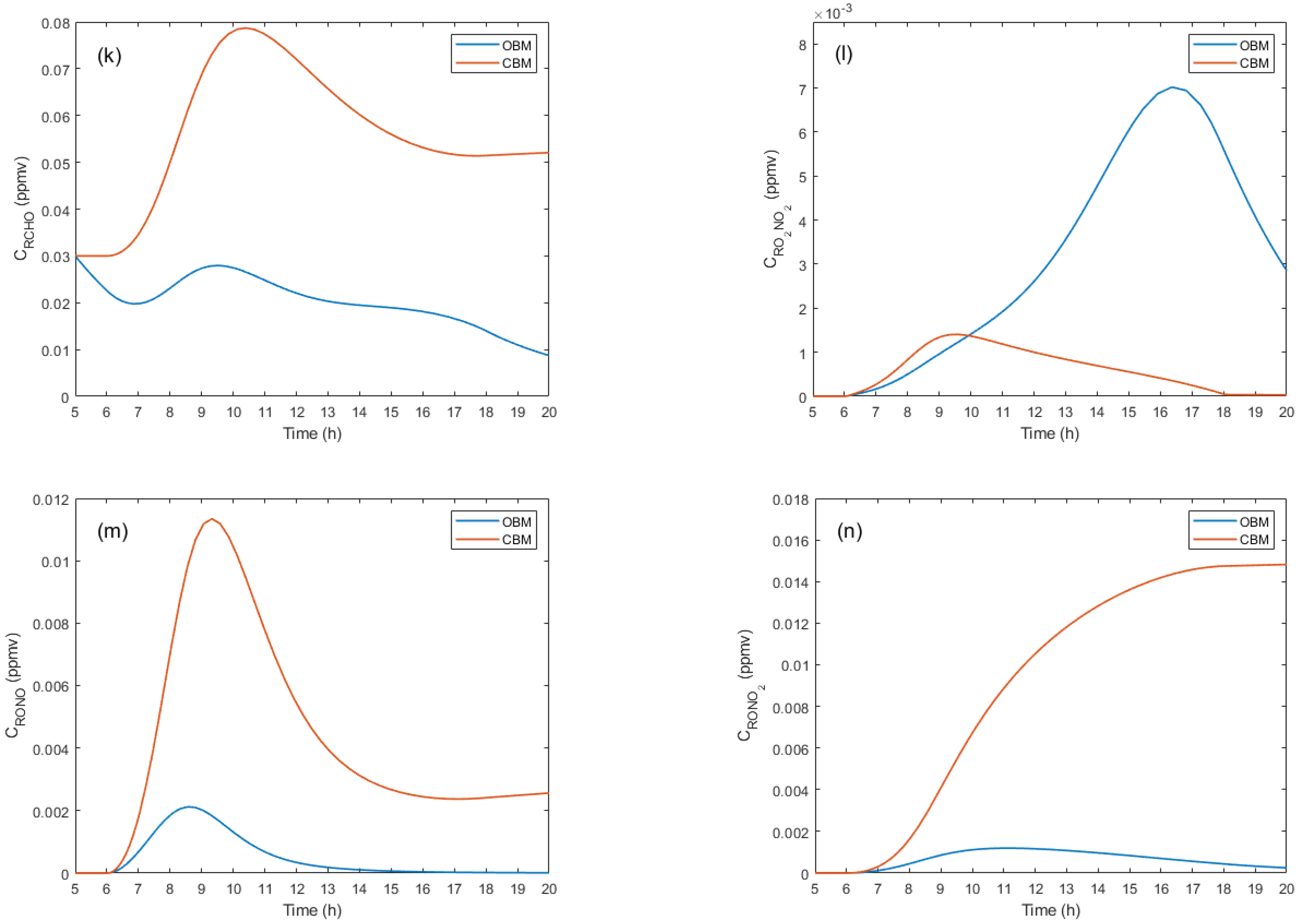Mathematical Modeling of Photochemical and Chemical Interactions in Photochemical Smog Formation
Abstract
1. Introduction
2. Materials and Methods
2.1. Mathematical Model
2.2. Reaction Mechanism
- Photolysis of and basic photolytic cycle
- Chemistry of nitrogen trioxide:
- Nitrous acid and peroxy nitrous acid chemistry
- Photolysis of nitrous acid:
- Nitrous acid chemistry
- Conversion of to
- Nitric acid formation:
- Hydroperoxyl radical formation
- Photolysis of ozone
- Photolysis of formaldehyde
- Chemistry of formaldehyde
- Photolysis of higher aldehydes
- Higher aldehyde chemistry
- Olefin chemistry:
- Alkane chemistry:
- Aromatic chemistry
- Alkoxyl radical chemistry
- Photolysis and chemistry of
- Peroxy nitrate chemistry
- Peroxyacyl nitrate chemistry:
- Dinitrogen pentoxide chemistry
- Ozone removal steps
- Ozone wall loss for smog chamber experiments
- Hydrogen peroxide production and photolysis
- Recombination reaction for peroxyalkyl radicals
2.3. Mass Transfer Equations Derived from the Reaction Mechanism
- : Incoming concentration of pollutant i in the control volume, ppm
- : Temporal concentration of pollutant i, ppmv
- : Reaction rate of component i, ppmv/h
- : Emission rate of pollutant i, ppmv/h
- Net volumetric flow of i, ppmv/h
- Residence time, h
2.4. Atmospheric Parameters
- Atmospheric pressure at sea level, 101,325 Pa
- Atmospheric pressure at any altitude
- Adiabatic temperature gradient, 0.0065 K/m
- Temperature at sea level, fluctuating between 273 K and 298 K
- Gravitational acceleration, 9.81 m/s2
- Molecular mass of air, 0.02896 kg/mol
- Universal gas constant, 8.314 J/mol K
- Altitude above sea level, m
- Scale height, m
- Air column height, m
- Mass flow velocity, kg/m2h
- Gas column density, kg/m3
- Horizontal air velocity in the horizontal direction, m/s
- Length of the control volume, m
- Width of the control volume, m
- Control volume, m3
- Volumetric flow rate, m3/h
2.5. Flow Parameters
2.6. Atmospheric Stability
2.7. Characteristics of the Developed Program
- ▪
- Reaction rate constants given in Section 2.2. Reaction Mechanism;
- ▪
- Initial concentration of all pollutants in this kinetic model;
- ▪
- Average temperature of the troposphere;
- ▪
- Start of the simulation process;
- ▪
- End of the simulation process;
- ▪
- Numerical resolution algorithm for ordinary differential equations: stiff method.
- ▪
- Control volume;
- ▪
- Mass flow velocity;
- ▪
- Altitude above sea level;
- ▪
- Height of the air column (thermal inversion height);
- ▪
- Density and pressure of the air column.
2.8. Typical Initial Concentration Values
3. Results
3.1. Closed-Box Model
- ▪
- Photochemical pollutants: Compounds such as , , *, *, *, , , , , *, *, *, , , and * show concentration peaks between 07:30 and 14:00, followed by a decrease as the intensity of solar radiation diminishes, reaching a minimum at 18:00. After this point, chemical reactions continue without the intervention of solar radiation.
- ▪
- Continuously decreasing pollutants: Other pollutants such as , , , , , and , tend to show a decrease in their concentrations because the generation rate is lower than the consumption rate. However, this behavior is nonlinear, as the concentration of each component depends on variations in the concentration of other components due to system dynamics.
- ▪
- and : The concentrations of and exhibit inverse behavior. The concentration decreases while that of increases. Both compounds directly influence the formation of tropospheric ozone, and this pattern is observed at the simulated temperatures, being the direct result of the reaction mechanism that regulates the dynamics of the relationship between these two compounds.
- ▪
- Effect of temperature: The analysis of pollutants as a function of temperature was grouped into two categories:
- ∘
- Compounds with concentration peaks: For compounds such as *, , , , *, *, *, *, , and , a direct relationship with temperature is observed, as their maximum concentrations increase with rising temperature. In contrast, , , , and show an inverse relationship with temperature.
- ∘
- Compounds without concentration peaks: In the case of compounds such as , , , *, and , an inverse relationship with temperature is observed. For , , and , the relationship is also inverse, while for , , , and , concentration changes with temperature are minimal.
3.2. Open-Box Model
4. Discussion
5. Conclusions
Author Contributions
Funding
Data Availability Statement
Conflicts of Interest
References
- Ilić, P.; Popović, Z.; Nešković Markić, D. Assessment of Meteorological Effects and Ozone Variation in Urban Area. Ecol. Chem. Eng. 2020, 27, 373–385. [Google Scholar] [CrossRef]
- Manisalidis, I.; Stavropoulou, E.; Stavropoulos, A.; Bezirtzoglou, E. Environmental and Health Impacts of Air Pollution: A Review. Front. Public Health 2020, 8, 505570. [Google Scholar] [CrossRef]
- Wang, M.; Wang, J.; Wang, P.; Wang, Z.; Tang, S.; Qian, G.; Liu, T.; Chen, W. Multi-Pass Cavity-Enhanced Raman Spectroscopy of Complex Natural Gas Components. Anal. Chim. Acta 2025, 1336, 343463. [Google Scholar] [CrossRef]
- Chen, L.; Cui, B.; Zhang, C.; Hu, X.; Wang, Y.; Li, G.; Chang, L.; Liu, L. Impacts of Fuel Stage Ratio on the Morphological and Nanostructural Characteristics of Soot Emissions from a Twin Annular Premixing Swirler Combustor. Environ. Sci. Technol. 2024, 58, 10558–10566. [Google Scholar] [CrossRef]
- Chen, L.; Cao, Y.; Hu, X.; Zhang, B.; Chen, X.; Cui, B.; Xu, J.; Yu, T.; Xu, Z. Raman Spectral Optimization for Soot Particles: A Comparative Analysis of Fitting Models and Machine Learning Enhanced Characterization in Combustion Systems. Build Environ. 2025, 271, 112600. [Google Scholar] [CrossRef]
- Tao, L.; Wu, H.; Wang, J.; Li, B.; Wang, X.-Q.; Ning, P. Removal of SO2 from Flue Gas Using Bayer Red Mud: Influence Factors and Mechanism. J. Cent. South Univ. 2019, 26, 467–478. [Google Scholar] [CrossRef]
- Liu, Y.; Li, B.; Lei, X.; Liu, S.; Zhu, H.; Ding, E.; Ning, P. Novel Method for High-Performance Simultaneous Removal of NOx and SO2 by Coupling Yellow Phosphorus Emulsion with Red Mud. Chem. Eng. J. 2022, 428, 131991. [Google Scholar] [CrossRef]
- Paraschiv, S.; Barbuta-Misu, N.; Paraschiv, S.L. Influence of NO2, NO and Meteorological Conditions on the Tropospheric O3 Concentration at an Industrial Station. Energy Rep. 2020, 6, 231–236. [Google Scholar] [CrossRef]
- Rathore, A.; Gopikrishnan, G.S.; Kuttippurath, J. Changes in Tropospheric Ozone over India: Variability, Long-Term Trends and Climate Forcing. Atmos. Environ. 2023, 309, 119959. [Google Scholar] [CrossRef]
- Hoffman, F.M.; Nair, U.S.; Vanessa Adams, S.; Kai Juarez, E.; Petersen, M.R. A Comparison of Machine Learning Methods to Forecast Tropospheric Ozone Levels in Delhi. Atmosphere 2021, 13, 46. [Google Scholar] [CrossRef]
- Sahu, S.K.; Chen, L.; Liu, S.; Xing, J.; Mathur, R. Effect of Future Climate Change on Stratosphere-to-Troposphere-Exchange Driven Ozone in the Northern Hemisphere. Aerosol Air Qual. Res. 2023, 23, 220414. [Google Scholar] [CrossRef]
- Liu, P.; Song, H.; Wang, T.; Wang, F.; Li, X.; Miao, C.; Zhao, H. Effects of Meteorological Conditions and Anthropogenic Precursors on Ground-Level Ozone Concentrations in Chinese Cities. Environ. Pollut. 2020, 262, 114366. [Google Scholar] [CrossRef]
- Frei, M.; Ashrafuzzaman, M.; Piepho, H.P.; Herzog, E.; Begum, S.N.; Islam, M.M. Evidence for Tropospheric Ozone Effects on Rice Production in Bangladesh. Sci. Total Environ. 2024, 909, 168560. [Google Scholar] [CrossRef] [PubMed]
- Naqvi, H.R.; Mutreja, G.; Hashim, M.; Singh, A.; Nawazuzzoha, M.; Naqvi, D.F.; Siddiqui, M.A.; Shakeel, A.; Chaudhary, A.A.; Naqvi, A.R. Global Assessment of Tropospheric and Ground Air Pollutants and Its Correlation with COVID-19. Atmos. Pollut. Res. 2021, 12, 101172. [Google Scholar] [CrossRef] [PubMed]
- Madronich, S.; Sulzberger, B.; Longstreth, J.D.; Schikowski, T.; Andersen, M.P.S.; Solomon, K.R.; Wilson, S.R. Changes in Tropospheric Air Quality Related to the Protection of Stratospheric Ozone in a Changing Climate. Photochem. Photobiol. Sci. 2023, 22, 1129–1176. [Google Scholar] [CrossRef]
- Iungman, T.; Khomenko, S.; Barboza, E.P.; Cirach, M.; Gonçalves, K.; Petrone, P.; Erbertseder, T.; Taubenböck, H.; Chakraborty, T.; Nieuwenhuijsen, M. The Impact of Urban Configuration Types on Urban Heat Islands, Air Pollution, CO2 Emissions, and Mortality in Europe: A Data Science Approach. Lancet Planet. Health 2024, 8, e489–e505. [Google Scholar] [CrossRef]
- Chiacchiaretta, P.; Aruffo, E.; Mascitelli, A.; Colangeli, C.; Palermi, S.; Bianco, S.; Di Carlo, P. Inland O3 Production Due to Nitrogen Dioxide Transport Downwind a Coastal Urban Area: A Neural Network Assessment. Sustainability 2024, 16, 6355. [Google Scholar] [CrossRef]
- Wang, J.; Yang, Y.; Zhang, Y.; Niu, T.; Jiang, X.; Wang, Y.; Che, H. Influence of Meteorological Conditions on Explosive Increase in O3 Concentration in Troposphere. Sci. Total Environ. 2019, 652, 1228–1241. [Google Scholar] [CrossRef]
- Nguyen, D.H.; Lin, C.; Vu, C.T.; Cheruiyot, N.K.; Nguyen, M.K.; Le, T.H.; Lukkhasorn, W.; Vo, T.D.H.; Bui, X.T. Tropospheric Ozone and NOx: A Review of Worldwide Variation and Meteorological Influences. Environ. Technol. Innov. 2022, 28, 102809. [Google Scholar] [CrossRef]
- Real, E.; Megaritis, A.; Colette, A.; Valastro, G.; Messina, P. Atlas of Ozone Chemical Regimes in Europe. Atmos. Environ. 2024, 320, 120323. [Google Scholar] [CrossRef]
- Velázquez de Castro, F. Modelización y Análisis de Las Concentraciones de Ozono Troposférico; Universidad Complutense de Madrid, Servicio de Publicaciones: Ayreusburg, Spain, 2003; ISBN 978-84-669-1664-6. [Google Scholar]
- Jion, M.M.M.F.; Jannat, J.N.; Mia, M.Y.; Ali, M.A.; Islam, M.S.; Ibrahim, S.M.; Pal, S.C.; Islam, A.; Sarker, A.; Malafaia, G.; et al. A Critical Review and Prospect of NO2 and SO2 Pollution over Asia: Hotspots, Trends, and Sources. Sci. Total Environ. 2023, 876, 162851. [Google Scholar] [CrossRef] [PubMed]
- Malytska, L.; Ladstätter-Weißenmayer, A.; Galytska, E.; Burrows, J.P. Assessment of Environmental Consequences of Hostilities: Tropospheric NO2 Vertical Column Amounts in the Atmosphere over Ukraine in 2019–2022. Atmos. Environ. 2024, 318, 120281. [Google Scholar] [CrossRef]
- Kafle, J.; Adhikari, K.P.; Poudel, E.P.; Pant, R.R. Mathematical Modeling of Pollutants Dispersion in the Atmosphere. J. Nepal. Math. Soc. 2024, 7, 61–70. [Google Scholar] [CrossRef]
- McRae, G.J.; Goodin, W.R.; Seinfeld, J.H. Mathematical Modeling of Photochemical Air Pollution; Pasadena, CA, USA, 1982; Available online: https://core.ac.uk/download/pdf/216149675.pdf (accessed on 13 September 1999).
- Silva-Quiroz, R.; Rivera, A.L.; Ordoñez, P.; Gay-Garcia, C.; Frank, A. Atmospheric Blockages as Trigger of Environmental Contingencies in Mexico City. Heliyon 2019, 5, e02099. [Google Scholar] [CrossRef]
- Tesche, T.W. Comparison of Two Numerical Schemes for Integrating the Atmospheric Diffusion Equation: Evaluation with Atmospheric Data. Math. Model. 1987, 9, 507–519. [Google Scholar] [CrossRef]
- Lin, C.; Wang, Y.; Ooka, R.; Flageul, C.; Kim, Y.; Kikumoto, H.; Wang, Z.; Sartelet, K. Modeling of Street-Scale Pollutant Dis-persion by Coupled Simulation of Chemical Reaction, Aerosol Dynamics, and CFD. Atmos. Chem. Phys. 2023, 23, 1421–1436. [Google Scholar] [CrossRef]
- Leelőssy, Á.; Molnár, F.; Izsák, F.; Havasi, Á.; Lagzi, I.; Mészáros, R. Dispersion Modeling of Air Pollutants in the Atmosphere: A Review. Cent. Eur. J. Geosci. 2014, 6, 257–278. [Google Scholar] [CrossRef]
- Pisso, I.; Real, E.; Law, K.S.; Legras, B.; Bousserez, N.; Attié, J.L.; Schlager, H. Estimation of Mixing in the Troposphere from Lagrangian Trace Gas Reconstructions during Long-Range Pollution Plume Transport. J. Geophys. Res. Atmos. 2009, 114, 19301. [Google Scholar] [CrossRef]
- Ulfah, S.; Awalluddin, S. A; Wahidin. Advection-Diffusion Model for the Simulation of Air Pollution Distribution from a Point Source Emission. J. Phys. Conf. Ser. 2018, 948, 012067. [Google Scholar] [CrossRef]
- Moreira, D.; Xavier, P.; Palmeira, A.; Nascimento, E. New Approach to Solving the Atmospheric Pollutant Dispersion Equation Using Fractional Derivatives. Int. J. Heat. Mass. Transf. 2019, 144, 118667. [Google Scholar] [CrossRef]
- Ravshanov, N.; Muradov, F.; Akhmedov, D. Operator Splitting Method for Numerical Solving the Atmospheric Pollutant Dispersion Problem. J. Phys. Conf. Ser. 2020, 1441, 012164. [Google Scholar] [CrossRef]
- Atkinson, R.; Lloyd, A.C. Evaluation of Kinetic and Mechanistic Data for Modeling of Photochemical Smog. J. Phys. Chem. Ref. Data 1984, 13, 315–444. [Google Scholar] [CrossRef]
- Atkinson, R.; Baulch, D.L.; Cox, B.A.; Hampson, R.F.; Kerr, J.A.; Troe, J. Towards a Quantitative Understanding of Atmospheric Ozone. Planet. Space Sci. 1989, 37, 1605–1620. [Google Scholar] [CrossRef]
- Brewer, D.A.; Augustsson, T.R.; Levine, J.S. The Photochemistry of Anthropogenic Nonmethane Hydrocarbons in the Tropo-sphere. J. Geophys. Res. 1983, 88, 6683–6695. [Google Scholar] [CrossRef]
- Rawat, P.; Naja, M.; Rajwar, M.C.; Irie, H.; Lerot, C.; Kumar, M.; Lal, S. Long-Term Observations of NO2, SO2, HCHO, and CHOCHO over the Himalayan Foothills: Insights from MAX-DOAS, TROPOMI, and GOME-2. Atmos. Environ. 2024, 336, 120746. [Google Scholar] [CrossRef]
- Gao, T.; Xu, D.; Mi, Y.; Lu, Y. Simulation Analysis of NO2 Pollution Diffusion Law Based on Gauss Plume Model: A Case Study from Hebei Province. IOP Conf. Ser. Earth Environ. Sci. 2020, 555, 012090. [Google Scholar] [CrossRef]
- Narasimhan, R.; Keller, J.; Subramaniam, G.; Raasch, E.; Croley, B.; Duncan, K.; Potter, W.T. Ozone Modeling Using Neural Networks. J. Appl. Meteorol. 2000, 39, 291–296. [Google Scholar] [CrossRef]
- Seinfeld, J.H.; Pandis, S.N. Atmospheric Chemistry and Physics: From Air Pollution to Climate Change, 3rd ed.; John Wiley & Sons: Hoboken, NJ, USA, 2019; ISBN 978-1-118-94740-1. [Google Scholar]
- Atkinson, R.; Baulch, D.L.; Cox, R.A.; Crowley, J.N.; Hampson, R.F.; Hynes, R.G.; Jenkin, M.E.; Rossi, M.J.; Troe, J.; Wallington, T.J. Evaluated Kinetic and Photochemical Data for Atmospheric Chemistry: Volume IV–Gas Phase Reactions of Organic Halogen Species. Atmos. Chem. Phys. 2008, 8, 4141–4496. [Google Scholar] [CrossRef]
- Calvert, J.G. The Chemistry of the Atmosphere: Its Impact on Global Change, 1st ed.; Blackwell Publishing: Oxford, UK, 1994. [Google Scholar]
- Grell, G.A.; Peckham, S.E.; Schmitz, R.; McKeen, S.A.; Frost, G.; Skamarock, W.C.; Eder, B. Fully Coupled “Online” Chemistry within the WRF Model. Atmos. Environ. 2005, 39, 6957–6975. [Google Scholar] [CrossRef]
- Simpson, D.; Benedictow, A.; Berge, H.; Bergström, R.; Emberson, L.D.; Fagerli, H.; Flechard, C.R.; Hayman, G.D.; Gauss, M.; Jonson, J.E.; et al. The EMEP MSC-W Chemical Transport Model – Technical Description. Atmos. Chem. Phys. 2012, 12, 7825–7865. [Google Scholar] [CrossRef]
- Lu, X.; Zhang, L.; Wu, T.; Long, M.S.; Wang, J.; Jacob, D.J.; Zhang, F.; Zhang, J.; Eastham, S.D.; Hu, L.; et al. Development of the Global Atmospheric Chemistry General Circulation Model BCC-GEOS-Chem v1.0: Model Description and Evaluation. Geosci. Model. Dev. 2020, 13, 3817–3838. [Google Scholar] [CrossRef]
- Emery, C.; Baker, K.; Wilson, G.; Yarwood, G. Comprehensive Air Quality Model with Extensions: Formulation and Evaluation for Ozone and Particulate Matter over the US. Atmosphere 2024, 15, 1158. [Google Scholar] [CrossRef]
- Falls, A.H.; McRae, G.J.; Seinfeld, J.H. Sensitivity and Uncertainty of Reaction Mechanisms for Photochemical Air Pollution. Int. J. Chem. Kinet. 1979, 11, 1137–1162. [Google Scholar] [CrossRef]
- Bazzell, C.C.; Peters, L.K. The Transport of Photochemical Pollutants to the Background Troposphere. Atmos. Environ. (1967) 1981, 15, 957–968. [Google Scholar] [CrossRef]
- Krysztofiak, G.; Catoire, V.; Poulet, G.; Marécal, V.; Pirre, M.; Louis, F.; Canneaux, S.; Josse, B. Detailed Modeling of the At-mospheric Degradation Mechanism of Very-Short Lived Brominated Species. Atmos. Environ. 2012, 59, 514–532. [Google Scholar] [CrossRef]
- Hampson, R.F.; Garvin, D. Reaction Rate and Photochemical Data for Atmospheric Chemistry, 1977; US Department of Commerce, National Bureau of Standards: Gaithersburg, MD, USA, 1978; Volume 513.
- Leone, J.A.; Seinfeld, J.H. Comparative Analysis of Chemical Reaction Mechanisms for Photochemical Smog. Atmos. Environ. (1967) 1985, 19, 437–464. [Google Scholar] [CrossRef]
- Kyan, C.P.; Seinfeld, J.H. Determination of Optimal Multiyear Air Pollution Control Policies. J. Dyn. Syst. Meas. Control 1972, 94, 266–274. [Google Scholar] [CrossRef]
- McRae, G.J.; Goodin, W.R.; Seinfeld, J.H. Mathematical Modelling of Photochemical Air Pollution. In Proceedings of the AIAA Monographs, Pasadena, CA, USA, 18 June 1982; Volume 25, pp. 67–77. [Google Scholar]
- McRae, G.J.; Goodin, W.R.; Seinfeld, J.H. Numerical Solution of the Atmospheric Diffusion Equation for Chemically Reacting Flows. J. Comput. Phys. 1982, 45, 1–42. [Google Scholar] [CrossRef]
- Cutlip, M.B.; Shacham, M. Resolucion de Problemas En Ingenieria Quimica y Bioquimica Con POLYMATH, EXCEL y MATLAB, 2nd ed.; Prentice Hall: Madrid, Spain, 2008; ISBN 9788483224618. [Google Scholar]
- Ahrens, C.D.; Henson, R. Meteorology Today: An Introduction to Weather, Climate, and the Environment, 12th ed.; Brooks Cole: Boston, MA, USA, 2018. [Google Scholar]
- Burden, R.L.; Faires, J.D. Numerical Analysis, 9th ed.; Brooks/Cole, Cencag Learning: Boston, MA, USA, 2011. [Google Scholar]
- Hairer, E.; Wanner, G. Solving Ordinary Differential Equations II; Springer Series in Computational Mathematics; Springer: Berlin/Heidelberg, Germany, 1996; Volume 14, ISBN 978-3-642-05220-0. [Google Scholar]
- Erickson, L.E.; Newmark, G.L.; Higgins, M.J.; Wang, Z. Nitrogen Oxides and Ozone in Urban Air: A Review of 50 plus Years of Progress. Env. Prog. Sustain. Energy 2020, 39, e13484. [Google Scholar] [CrossRef]
- Monks, P.S.; Archibald, A.T.; Colette, A.; Cooper, O.; Coyle, M.; Derwent, R.; Fowler, D.; Granier, C.; Law, K.S.; Mills, G.E.; et al. Tropospheric Ozone and Its Precursors from the Urban to the Global Scale from Air Quality to Short-Lived Climate Forcer. Atmos. Chem. Phys. 2015, 15, 8889–8973. [Google Scholar] [CrossRef]
- Finlayson-Pitts, B.J.; Pitts, J.N. Chemistry of the Upper and Lower Atmosphere: Theory, Experiments, and Applications; Academic Press: San Diego, CA, USA, 1999. [Google Scholar]
- Xuan, H.; Zhao, Y.; Ma, Q.; Chen, T.; Liu, J.; Wang, Y.; Liu, C.; Wang, Y.; Liu, Y.; Mu, Y.; et al. Formation mechanisms and atmospheric implications of summertime nitrous acid (HONO) during clean, ozone pollution and double high-level PM2.5 and O3 pollution periods in Beijing. Sci. Total Environ. 2023, 857, 159538. [Google Scholar] [CrossRef] [PubMed]
- Elshorbany, Y.; Ziemke, J.R.; Strode, S.; Petetin, H.; Miyazaki, K.; De Smedt, I.; Pickering, K.; Seguel, R.J.; Worden, H.; Emmerichs, T.; et al. Tropospheric Ozone Precursors: Global and Regional Distributions, Trends, and Variability. Atmos. Chem. Phys. 2024, 24, 12225–12257. [Google Scholar] [CrossRef]
- Lodge, J.P. Determination of C1–C5 Aldehydes in Ambient Air and Source Emissions as 2,4-Dinitrophenylhydrazones by HPLC. In Methods of Air Sampling and Analysis; Routledge: New York, NY, USA, 2017; pp. 293–295. [Google Scholar]
- Gilman, J.B.; Lerner, B.M.; Kuster, W.C.; Goldan, P.D.; Warneke, C.; Veres, P.R.; Roberts, J.M.; De Gouw, J.A.; Burling, I.R.; Yokelson, R.J. Biomass Burning Emissions and Potential Air Quality Impacts of Volatile Organic Compounds and Other Trace Gases from Fuels Common in the US. Atmos. Chem. Phys. 2015, 15, 13915–13938. [Google Scholar] [CrossRef]
- Jacob, D.J. Introduction to Atmospheric Chemistry; Princeton University Press: Princeton, NJ, USA, 1999. [Google Scholar]
- Atkinson, R. Atmospheric Chemistry of VOCs and NOx. Atmos. Environ. 2000, 34, 2063–2101. [Google Scholar] [CrossRef]
- Travis, K.R.; Nault, B.A.; Crawford, J.H.; Bates, K.H.; Blake, D.R.; Cohen, R.C.; Fried, A.; Hall, S.R.; Huey, L.G.; Lee, Y.R.; et al. Impact of Improved Representation of Volatile Organic Compound Emissions and Production of NOx Reservoirs on Modeled Urban Ozone Production. Atmos. Chem. Phys. 2024, 24, 9555–9572. [Google Scholar] [CrossRef]
- Carter, W.P.L. Documentation of the SAPRC-99 Chemical Mechanism for VOC Reactivity Assessment; Riverside; Air Pollution Research Center and College of Engineering: Carmel, CA, USA, 1999; Available online: https://intra.engr.ucr.edu/~carter/pubs/s99doc.pdf (accessed on 13 September 1999).
- Jacob, D.J.; Wofsy, S.C. Photochemistry of Biogenic Emissions over the Amazon Forest. J. Geophys. Res. 1988, 93, 1477–1486. [Google Scholar] [CrossRef]
- Sun, Y.; Wang, L.; Wang, Y.; Quan, L.; Zirui, L. In Situ Measurements of SO2, NOx, NOy, and O3 in Beijing, China during August 2008. Sci. Total Environ. 2011, 409, 933–940. [Google Scholar] [CrossRef]
- Atkinson, R. Gas-Phase Tropospheric Chemistry of Organic Compounds: A Review. Atmos. Environ. Part A Gen. Top. 1990, 24, 1–41. [Google Scholar] [CrossRef]
- Goldstein, A.H.; Galbally, I.E. Known and Unexplored Organic Constituents in the Earth’s Atmosphere. Environ. Sci. Technol. 2007, 41, 1514–1521. [Google Scholar] [CrossRef]
- Jung, J.; Choi, Y.; Souri, A.H.; Mousavinezhad, S.; Sayeed, A.; Lee, K. The Impact of Springtime-Transported Air Pollutants on Local Air Quality With Satellite-Constrained NOx Emission Adjustments Over East Asia. J. Geophys. Res. Atmos. 2022, 127, e2021JD035251. [Google Scholar] [CrossRef]





| Formula | Name | Formula | Name |
|---|---|---|---|
| NO | Nitric Oxide | NO2 | Nitrogen Dioxide |
| NO3 | Nitrogen Trioxide | O3 | Ozone |
| HCHO | Formaldehide | RCHO | Higher Aldehydes |
| OLE | Lumped Olefins | ALK | Lumped Alkanes |
| ARO | Lumped Aromatics | C2H4 | Ethylene |
| CO | Carbon Monoxide | H2O2 | Hydrogen Peroxide |
| PAN | Peroxyactyl Nitrate | HONO | Nitrous Acid |
| RONO | Alkyl Nitrite | RO2 NO2 | Peroxyalkyl Nitrate |
| N2O5 | Pentoxide Dinitrogen | HO2NO2 | Peroxynitric Acid |
| RONO2 | Alkyl Nitrate | HONO2 | Nitric Acid |
| H2 | Hydrogen | CO2 | Carbon Dioxide |
| H2O | Water | O2 | Oxygen |
| (O, O(1D), O(3P)) (1) | Monatomic oxygen, singlet and triplet | M | Third Body |
| Peroxyacyl Radical | Hydroperoxyl Radical | ||
| Alkylperoxy Radical | Hydroxyl Radical | ||
| Alcoxyl Radical | Formyl Radical |
| Reaction Rate | ||
|---|---|---|
| Component | Initial Concentration (ppm) | Emission Rate (ppm/h) | Inlet Flow (ppm/h) OBM | |
|---|---|---|---|---|
| CBM | OBM | |||
| 0.01–10 (1) | 0.02 | 0.02 | 0.001 | |
| 0.01–5 (0.05) | 0.01 | 0.01 | 0.003 | |
| Traces (0) | 0 | 0 | 0.00001 | |
| Traces (0) | 0 | 0 | 0 | |
| 0.00001–0.0001 (0.00001) | 0 | 0 | 0 | |
| Traces (0) | 0 | 0 | 0 | |
| Traces (0) | 0 | 0 | 0 | |
| 0.05–3 (0.1) | 0.03 | 0.03 | 0.0001 | |
| 0.01–0.1 (0.02) | 0 | 0 | 0 | |
| 0.1–5 (0.2) | 0 | 0 | 0.002 | |
| 0.01–2 (1) | 0.1 | 0.1 | 0 | |
| 0.0001–0.001 (0.0005) | 0.0002 | 0.0002 | 0.00001 | |
| 0.05–10 (0.1) | 0.02 | 0.02 | 0.00001 | |
| 0.00001–0.0001 | 0 | 0 | 0 | |
| 0.00001–0.0001 (0.00005) | 0 | 0 | 0 | |
| 0.0001–0.001 (0.0005) | 0.000008 | 0.000008 | 0.000004 | |
| Traces (0) | 0 | 0 | 0 | |
| Traces (0) | 0 | 0 | 0 | |
| Traces (0) | 0 | 0 | 0 | |
| 0.5–1.5 (1) | 0 | 0 | 0 | |
| (420) | 0 | 0 | 420 | |
| 10,000–20,000 (15,000) | 0 | 0 | 15,000 | |
| (210,000) | 0 | 0 | 210,000 | |
| (1,000,000) | 0 | 0 | 1,000,000 | |
| Variables | Data |
|---|---|
| Temperature (K) | 278, 288, 298 |
| Height above sea level (m) | 0–4000 (2700) |
| Inversion layer height (m) | 100–800 (500) |
| Mass air flow rate (kg/m2h) | 100–400 (250) |
| Control volume length (m) | (1000) |
| Control volume width (m) | (200) |
Disclaimer/Publisher’s Note: The statements, opinions and data contained in all publications are solely those of the individual author(s) and contributor(s) and not of MDPI and/or the editor(s). MDPI and/or the editor(s) disclaim responsibility for any injury to people or property resulting from any ideas, methods, instructions or products referred to in the content. |
© 2025 by the authors. Licensee MDPI, Basel, Switzerland. This article is an open access article distributed under the terms and conditions of the Creative Commons Attribution (CC BY) license (https://creativecommons.org/licenses/by/4.0/).
Share and Cite
Carrasco-Venegas, L.A.; Castañeda-Pérez, L.G.; Martínez-Hilario, D.G.; Medina-Collana, J.T.; González-Fernández, J.V.; Gutiérrez-Cuba, C.; Cuba-Torre, H.R.; Pilco-Nuñez, A.; Ancieta-Dextre, C.A.; Rodriguez-Taranco, O.J. Mathematical Modeling of Photochemical and Chemical Interactions in Photochemical Smog Formation. Processes 2025, 13, 1384. https://doi.org/10.3390/pr13051384
Carrasco-Venegas LA, Castañeda-Pérez LG, Martínez-Hilario DG, Medina-Collana JT, González-Fernández JV, Gutiérrez-Cuba C, Cuba-Torre HR, Pilco-Nuñez A, Ancieta-Dextre CA, Rodriguez-Taranco OJ. Mathematical Modeling of Photochemical and Chemical Interactions in Photochemical Smog Formation. Processes. 2025; 13(5):1384. https://doi.org/10.3390/pr13051384
Chicago/Turabian StyleCarrasco-Venegas, Luis Américo, Luz Genara Castañeda-Pérez, Daril Giovanni Martínez-Hilario, Juan Taumaturgo Medina-Collana, José Vulfrano González-Fernández, Cesar Gutiérrez-Cuba, Héctor Ricardo Cuba-Torre, Alex Pilco-Nuñez, Carlos Alejandro Ancieta-Dextre, and Oscar Juan Rodriguez-Taranco. 2025. "Mathematical Modeling of Photochemical and Chemical Interactions in Photochemical Smog Formation" Processes 13, no. 5: 1384. https://doi.org/10.3390/pr13051384
APA StyleCarrasco-Venegas, L. A., Castañeda-Pérez, L. G., Martínez-Hilario, D. G., Medina-Collana, J. T., González-Fernández, J. V., Gutiérrez-Cuba, C., Cuba-Torre, H. R., Pilco-Nuñez, A., Ancieta-Dextre, C. A., & Rodriguez-Taranco, O. J. (2025). Mathematical Modeling of Photochemical and Chemical Interactions in Photochemical Smog Formation. Processes, 13(5), 1384. https://doi.org/10.3390/pr13051384







